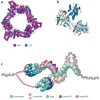Mechanisms for initiating cellular DNA replication
- PMID: 23746253
- PMCID: PMC4696014
- DOI: 10.1146/annurev-biochem-052610-094414
Mechanisms for initiating cellular DNA replication
Abstract
The initiation of DNA replication represents a committing step to cell proliferation. Appropriate replication onset depends on multiprotein complexes that help properly distinguish origin regions, generate nascent replication bubbles, and promote replisome formation. This review describes initiation systems employed by bacteria, archaea, and eukaryotes, with a focus on comparing and contrasting molecular mechanisms among organisms. Although commonalities can be found in the functional domains and strategies used to carry out and regulate initiation, many key participants have markedly different activities and appear to have evolved convergently. Despite significant advances in the field, major questions still persist in understanding how initiation programs are executed at the molecular level.
Figures






References
-
- Arias EE, Walter JC. Strength in numbers: preventing rereplication via multiple mechanisms in eukaryotic cells. Genes Dev. 2007;21(5):497–518. - PubMed
-
- Sutera VA, Jr, Lovett ST. The role of replication initiation control in promoting survival of replication fork damage. Mol Microbiol. 2006;60(1):229–39. - PubMed
-
- Iyer LM, Leipe DD, Koonin EV, Aravind L. Evolutionary history and higher order classification of AAA+ ATPases. J Struct Biol. 2004;146(1–2):11–31. - PubMed
-
- Liu J, Smith CL, DeRyckere D, DeAngelis K, Martin GS, Berger JM. Structure and function of Cdc6/Cdc18: implications for origin recognition and checkpoint control. Mol Cell. 2000;6(3):637–48. - PubMed
Publication types
MeSH terms
Substances
Grants and funding
LinkOut - more resources
Full Text Sources
Other Literature Sources

